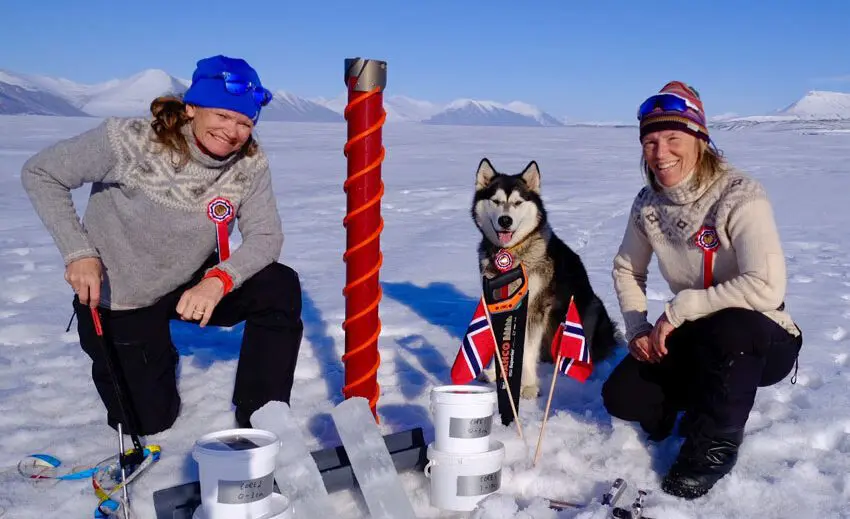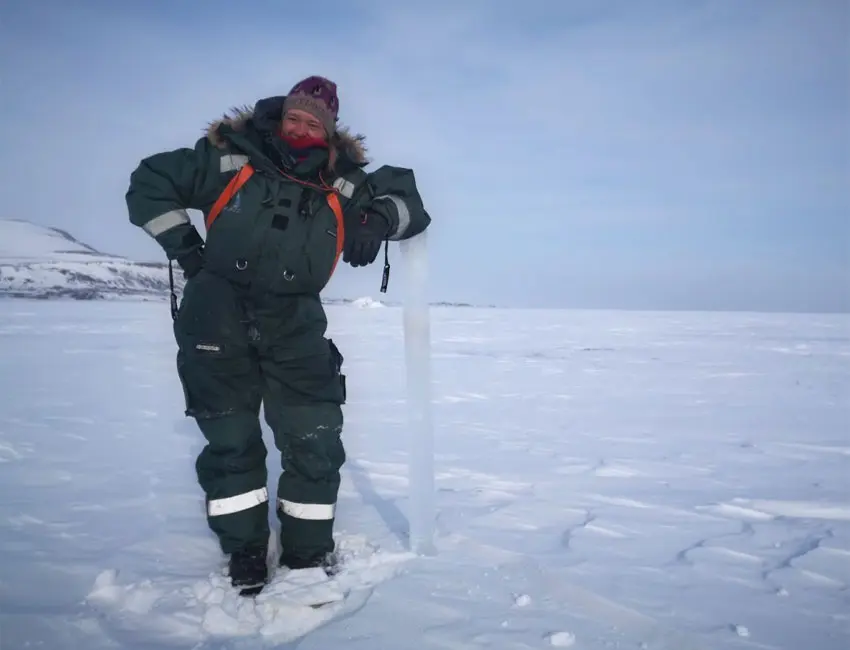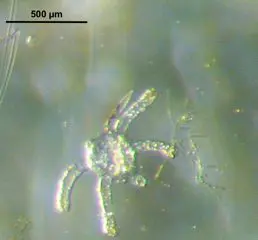2020 – A good sea ice year in Svalbard?

Hilde Fålun Strøm and Sunniva Sorby known as "Hearts in the Ice" have been at Bamsebu in Van Keulenfjorden since September 2019. Together with their faithful companion Ettra, they have taken ice cores for UNIS throughout the winter. Ice cores that are melted and analysed to study microscopic animals! In one square meter of sea ice, there can be up to 40,000 small larvae of benthic animals inside the ice. These small creepy crawlies actively graze on small algae (ice algae) that is seen as a brown layer both inside and on the underside of the sea ice in April and May. Photo: Sunniva Sorby on 17 May.
Top image: Hilde Fålun Strøm and Sunniva Sorby known as “Hearts in the Ice” have been at Bamsebu in Van Keulenfjorden since September 2019. Together with their faithful companion Ettra, they have taken ice cores for UNIS throughout the winter. Ice cores that are melted and analysed to study microscopic animals! In one square meter of sea ice, there can be up to 40,000 small larvae of benthic animals inside the ice. These small creepy crawlies actively graze on small algae (ice algae) that is seen as a brown layer both inside and on the underside of the sea ice in April and May. Photo: Sunniva Sorby on 17 May.
It has been hot, very hot, in the fjords of Svalbard since 2006. But over the past year we have seen a cooling down. More cold and fresh Arctic water has followed the coastal flow along the west coast and inflow of warm Atlantic water has slowed down, as low autumn and winter temperatures have cooled the fjords so that sea ice has formed again. In both Van Mijenfjorden and Wijdefjorden there were ice cover from the innermost to the outermost parts, while other fjords, such as Isfjorden and Kongsfjorden, had ice in the innermost fjord arms.
7 July 2020
Text: Janne E. Søreide, Vanessa Pitusi, Anna Vader, Cheshtaa Chitkara, Ragnheid Skogseth and Frank Nilsen, UNIS.
It has been hot, very hot, in the fjords of Svalbard since 2006. But over the past year we have seen a cooling down. More cold and fresh Arctic water has followed the coastal flow along the west coast and inflow of warm Atlantic water has slowed down, as low autumn and winter temperatures have cooled the fjords so that sea ice has formed again. In both Van Mijenfjorden and Wijdefjorden there were ice cover from the innermost to the outermost parts, while other fjords, such as Isfjorden and Kongsfjorden, had ice in the innermost fjord arms.
This winter, both the prevalence and thickness of the ice have been greater than in a long time. While the extent of sea ice can be captured by satellites, ice thickness data is scarce. But this spring, UNIS has collected data on both ice thickness and the biology from several fjords. It was measured up to 110 cm of ice thickness at the bottom of Billefjorden and between 60-80 cm of sea ice in a straight line from Nordenskiöldbreen to Pyramiden. Not since 2009 have we measured similar ice thicknesses in this area.
In Tempelfjorden, the sea ice was a good 70-80 cm from Kapp Schultz to Bjonahamna, and in Van Mijenfjorden we measured between 90 and 110 cm in the innermost fjord from Kapp Amsterdam to the entrance of Rindersbukta. In Van Keulenfjorden, Hilde Fålun Strøm and Sunniva Sorby (“Hearts in the ice”) can report up to 80 cm of ice thickness outside their cabin Bamsebu. The two have regularly measured ice thickness and taken important biological tests for UNIS this winter. Not surprisingly, it was Storfjorden who “took the record”. In Mohnbukta we measured 133 cm of ice thickness as late as 11 May. The measurements indicated that the ice was still growing in thickness here.

The ice in the Storfjorden area is very insidious. Normally the solid ice is only in the bays throughout the freezing season. As we move further out, the ice is always moving due to wind and current conditions, and it is not uncommon to encounter hole in the ice or open water despite cold and calm conditions. As the ice disappears due to wind and current and not due to melting during the freezing season, the seawater in the open areas of the ice is always at the freezing point. This makes the Storfjorden a large “ice factory”. When sea ice is formed, salt is released into the water below. Salt makes the water heavier and lowers the freezing point. In Storfjorden we recorded that the freezing point for the salty and cold seawater was at -1.9 ° C, while the freezing point on the west coast, where the salt content is lower, was between -1.8 ° C and -1.6 ° C.
Isfjorden was at its coldest in April and even the middle Isfjorden (Karlskronadjupet; IsK) was near the freezing point. Sometime in May, a change of weather occurred, and it became warmer both in the air and in the sea. This is due to solar heating, but also due to an influx of warmer water from the shelf off Isfjorden. Since April, the sea temperature in the surface of Adventfjorden has risen by a full +2.5 degrees. Intense melting from both the underside and the upper surface of the sea ice makes it disappear quickly and in June, the sea ice distribution was again slightly below the average from 1981-2010.
It will be exciting to see if we get good ice conditions next winter too. In order to follow the development and understand the system better, UNIS will continue its regular measurements in Isfjorden. In the fall, UNIS will also – when the last piece is in place – get an online sea station outside Bjørndalen-Hotellneset. This is funded through the Research Council’s infrastructure project SIOS InfraNor and will enable all interested parties to follow the sea temperature development.

In addition to temperature, the sea station will provide information on salinity, tides, current direction and wave height, as well as oxygen content and algae concentration in the water. The location of the sea station allows it to effectively capture pulses of warmer water entering Isfjorden. Such information can be critically important in the winter when the sea ice in regular scooter paths, such as Tempelfjorden, is not as solid as it has been this year. We witnessed this in 2017 with the tragic accident that happened there. The sea ice status of Svalbard in the winter of 2020 can be regarded as slightly above average when we compare sea ice distribution over the last 20-30 years. It remains to be seen if we will again experience such conditions as we had in the glorious years of 1998 and 2004 when the entire Isfjorden was covered by sea ice.


